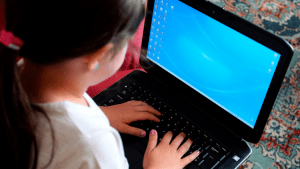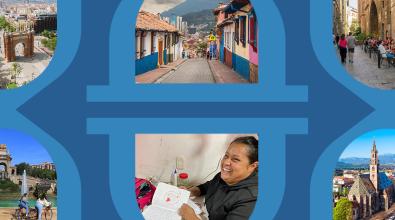The digital divide: How cities are closing the gap among students

When K-12 schools moved online in a rush last spring, it laid bare the long-festering problem of unequal access to high-speed internet. From Chicago to Los Angeles to Philadelphia, school participation plunged, especially among Black and Latinx students, in part because so many families lack broadband at home.
Now, cities across the country are launching dozens of initiatives aimed at chipping away at the digital divide. With many school systems returning again to online instruction, they’re hoping to start the new year strong and allay fears that COVID-19 will only deepen an already troubling racial academic achievement gap.
Last week, Washington, D.C., launched one of the most ambitious such efforts, called Internet for All. It’s aimed at paying 12 months of internet bills for 25,000 low-income families and is paid for with $3.3 million from the federal CARES Act. The city is calling, texting, and emailing eligible residents to let them know about the offer. “This investment continues our commitment not only to supporting families during virtual school term, but also to building a more digitally-inclusive DC in the long-term,” Mayor Muriel Bowser said.
Bowser’s move follows similar programs in other cities. Philadelphia’s PHLConnectED initiative, which is a partnership with Comcast, will supply free broadband for public-school families who don’t already have it through June 2022. Residents need only call 211 to sign up. Chicago Mayor Lori Lightfoot’s Chicago Connected program is credited with getting more students online when school started last week. About 84 percent of students logged in on the first day of class — a lower attendance rate than usual for the first day of in-person school, but much higher than virtual schools saw in the spring.
The internet isn’t all students need to get online, of course, and school districts have handed out millions of laptops, tablets, and other devices, many of which they already had on hand. Getting students broadband is in some ways trickier, especially for children who move around a lot. And it’s a problem that mayors, who often don’t control the schools, can do something about.
The urgency is only growing as the pandemic continues to shine a painful spotlight on racial and ethnic inequities in America. According to a recent study of the K-12 digital divide by Common Sense Media and Boston Consulting Group, 26 percent of Latinx students and 30 percent of Black students lack adequate connectivity, compared with 18 percent of White students.
Cities are tackling the problem from a number of different directions. In Little Rock, Ark., the city is purchasing 1,000 internet hotspots to hand out to families in need; Nashville, Tenn., purchased 17,000 hotspots for its students, and San Jose, Calif., is distributing 8,000. San Jose has 3,000 more available for a 90-day checkout at the public library.
Libraries factor into other cities’ internet plans. In Dallas, the libraries are closed but the city is boosting its free public WiFi service outside of libraries in underserved neighborhoods. Boston is doing the same at branch libraries, and has reopened its central library for socially distanced computer access. And libraries are a big part of San Francisco’s push to create “learning hubs” where 6,000 students from disadvantaged backgrounds are invited to go each day to take their virtual classes in small pods — free internet (and adult supervision) is part of the free offer.
[Read: Cities try ‘learning hubs’ to keep kids on track with online school]
In Tulsa, Okla., students living in public housing are a big focus. Nearly half of the city’s new $5.6 million investment in internet access is going toward bringing high-speed WiFi to all Tulsa Housing Authority complexes, a move that impacts nearly 2,500 families. Like the programs in Washington, D.C., Chicago, and Philadelphia, Tulsa will also provide a year of free internet service to families who don’t already have it — as well as fund “internet access navigators” to help students tackle technology challenges at home.
Tulsa Mayor G.T. Bynum said the initiative is a result of a data-driven analysis by an Internet Access Task Force led by the city, public schools, and two dozen other agencies. Their work found that 57,000 households in Tulsa, including 20,000 students, do not have fast, reliable internet at home. “We’re doing what is necessary, as we start this school year, to make sure Tulsa families, and in particular our youngest Tulsans, have access to the technology they need to get a great education,” Bynum said.

